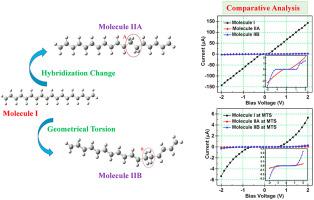Physica E: Low-dimensional Systems and Nanostructures ( IF 3.3 ) Pub Date : 2021-01-12 , DOI: 10.1016/j.physe.2021.114628 Kumar Gaurav , Boddepalli SanthiBhushan , German Mino-Galaz , Gonzalo Gutierrez , Anurag Srivastava

|
The polymers are usually insulators by nature, however those with inherent conjugation take an exception, hence called conducting polymers. Trans-polyacetylene is a conducting polymer with a HOMO-LUMO gap comparable to the band gap of silicon semiconductor. Thus, this conducting plastic is been widely studied to gain a better understanding of its properties, so as to revolutionize various technological fields. In this work, we provide a comprehensive report of the transport phenomenon (electrical as well as thermal) through trans-polyacetylene conducting polymer in presence of hybridization and torsion defects. Moreover, in order to gain insights of the polymer behavior in real time device environment, it has been subjected to external tensile stress and studied for the transport properties. Our analysis revealed that this conducting polymer is very sensitive to hybridization and torsion defects, with about 66 times reduction in drive current for hybridization defect, while the torsion defect has caused a further current degradation by 1.45 times. The defects are observed to cause lesser degradation in thermal conductance in comparison to the electrical conductance. Interestingly, the simultaneous induction of hybridization and torsion defects in the polymer has resulted a negative differential resistance (NDR) effect. It has been observed that subjecting this polymer to external tensile stress not only reduces its stability but also greatly influences the drive current.
中文翻译:

杂化和扭转缺陷影响反式聚乙炔中的电子传输
聚合物本质上通常是绝缘体,但是具有固有共轭的聚合物除外,因此被称为导电聚合物。反式聚乙炔是一种导电聚合物,其HOMO-LUMO间隙可与硅半导体的带隙相比。因此,对该导电塑料进行了广泛的研究以更好地了解其性能,从而革新了各种技术领域。在这项工作中,我们提供了在存在杂交和扭转缺陷的情况下通过反式聚乙炔导电聚合物的传输现象(电和热)的综合报告。此外,为了深入了解聚合物在实时设备环境中的行为,已对其施加外部拉伸应力并研究了传输性能。我们的分析表明,这种导电聚合物对杂交和扭转缺陷非常敏感,杂交缺陷的驱动电流降低了约66倍,而扭转缺陷导致电流进一步降低了1.45倍。与电导率相比,观察到该缺陷导致热导率的降低较小。有趣的是,聚合物中杂化和扭转缺陷的同时诱导已导致负差动电阻(NDR)效应。已经观察到,使该聚合物经受外部拉伸应力不仅降低了其稳定性,而且极大地影响了驱动电流。而扭转缺陷导致电流进一步降低了1.45倍。与电导率相比,观察到该缺陷导致热导率的降低较小。有趣的是,聚合物中杂化和扭转缺陷的同时诱导已导致负差动电阻(NDR)效应。已经观察到,使该聚合物经受外部拉伸应力不仅降低了其稳定性,而且极大地影响了驱动电流。而扭转缺陷导致电流进一步降低了1.45倍。与电导率相比,观察到该缺陷导致热导率的降低较小。有趣的是,聚合物中杂化和扭转缺陷的同时诱导已导致负差动电阻(NDR)效应。已经观察到,使该聚合物经受外部拉伸应力不仅降低了其稳定性,而且极大地影响了驱动电流。



























 京公网安备 11010802027423号
京公网安备 11010802027423号